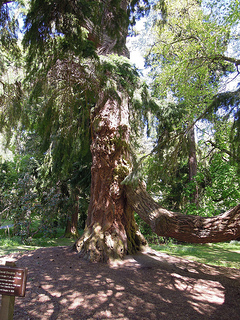The story of Scottish botanists Archibald Menzies, David Douglas, and the tree that bears both their names is a good example of the challenges of establishing either a binomial name or a common name for newly observed species. (Incidentally, the name Menzies is pronounced “MING-iss.”)
The tree is the Douglas fir, common in the forests of western North America, particularly in the Pacific Northwest. I learned recently that some people prefer the name Douglas-fir, with a hyphen, because it’s not a true fir. This is only the beginning of the complexities of this tree’s name. Today it’s one of the most economically important timber trees worldwide and is popular as a Christmas tree, but for many years it was quite a puzzle to botanists.
The name Douglas-fir honors David Douglas, who botanized in the New World during his brief but adventurous life in the early 19th century. Born in Scone, Scotland, he received training in botany in Scotland and made three plant-collecting expeditions for the Royal Horticultural Society of London. During his second and most successful trip (1823–1827), which took him to the Pacific Northwest, he introduced about 240 plant species to the British Isles, both garden plants and various timber trees. In 1827, he sent seeds from the Douglas-fir back home, estimating that this tree would do well there. Indeed, a tree grown from one of his seeds still graces the grounds of Scone Palace.

The journal of Douglas’s second North American trip tells of his travels and work under often difficult conditions, albeit in spectacularly beautiful places. On his third trip, Douglas returned to the Pacific Northwest and also visited Hawaii. It was there that he met his tragic and peculiar death at the age of 35. He died on Mauna Loa after he accidentally fell into a pit trap and was trampled by a wild bull. His name lives on (as douglasii) in the scientific names of more than 80 species of plants and animals.
Douglas was one of the first Europeans to climb Mauna Loa. The very first Europeans included Archibald Menzies, who climbed it with two other people in 1794 when he was serving as naturalist on the Vancouver Expedition of 1791–1795. Menzies was a doctor and botanist whose name also appears in the names of various New World plants that he observed and collected, including the scientific name of the Douglas-fir.
He visited the Pacific Northwest, where he collected specimens of the Douglas-fir and sent them back to England, but for some reason the tree evidently did not enter cultivation there at that time. Lewis and Clark also observed the tree and contributed drawings (and possibly specimens, although if so they are now lost) to fuel the discussion of how to categorize it and come up with a suitable scientific name.
This turned out to be a long and complicated business because of confusing resemblances to more familiar trees. Various genera were suggested: Pinus (pine), Tsuga (hemlock), Picea (spruce), and Abies (fir). The genus Pseudotsuga (false hemlock) was introduced in 1867, but the official name of Pseudotsuga menziesii was not formally accepted until the 1950s.
It’s quite a story, and I only hit the high points. This is an excellent example of how the elegance of binomial nomenclature often represents the distillation of many observations of an organism over a long and fascinating history. If you enjoy reading about scientific explorers, check out the writings of Douglas and Menzies listed below.
Learn more:
- Hawaii Nei 128 years ago (Archibald Menzies’s journal of his visits to the Hawaiian Islands on the Vancouver Expedition, published in 1920 with an introduction by W. F. Wilson; free Google e-book)
- Journal kept by David Douglas during his travels in North America, 1823–1827 (free e-book from the California Digital Library)
- Second Journey to the Northwestern Parts of the Continent of North America (article in The Quarterly of the Oregon Historical Society 6, 1 Sep 1905, consisting mostly of Douglas’s letters; available free of charge from JSTOR)
- A Nomenclatural Morass, a thorough recounting of the “long, complex tale” behind the scientific name of the Douglas-fir, by James L. Reveal